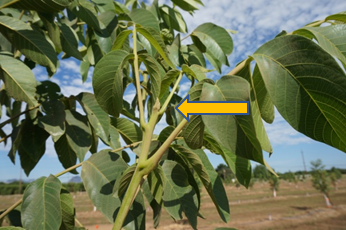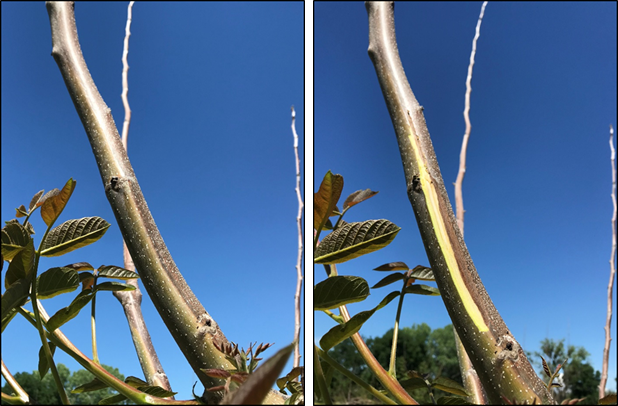Luke Milliron, UCCE Orchards Advisor, Butte, Tehama & Glenn Counties; & Janine Hasey, UCCE Orchards Advisor Emeritus, Sutter-Yuba & Colusa Counties
The sudden November 2018 freeze event that caused extensive damage in many walnut orchards is a stark reminder that we must do our best to prepare against extreme events. In addition to early freezes, fires and floods are extremes we will consider possible preparations against. Preparing for floods will appear in the winter issue of this newsletter.
Freeze. How can damage be prevented or reduced?
- Withdraw irrigation in September until a terminal bud (photo 1) is set on the trunk of young trees to harden the trees. After the terminal bud has set you can resume irrigation to avoid tree stress and defoliation, without the fear of pushing new growth.
- If there has not been adequate rainfall by the end of October, irrigate young and mature orchards so the soil is moist going into November. Rainfall adequacy can be determined by comparing rainfall totals with ET, and monitoring soil moisture levels by hand or with sensors. Trees with adequate soil moisture are better able to withstand low temperatures without damage than trees that are dry. Water conducts and stores more heat than air spaces.
- Continue to actively monitor soil moisture and freeze predictions in November. If a freeze is predicted and the soil is dry, it should be wetted 3 to 5 days prior to a freeze event to fill the air spaces so the soil will store more heat. The top foot is the most important and should be at field capacity (not too wet). Avoid water on the soil surface before a freeze since it will make the soil surface colder because of evaporative cooling.
- If freeze damage is suspected in the fall or winter, check the tissue for drying or browning (photos 2 & 3). Subsequent sunburn can further damage tissue on the southwest side of the tree. Paint the southwest side of damaged trees with 50% diluted (1:1 water to paint) white interior latex paint. Painting up to a week after the freeze event can decrease damage by half or more.
Mitigating Fire Risks.
Fires are an extreme event that are front of mind for Californians. Walnut orchards could be in the path of the next fire.
- Orchards have acted as a green wall, helping to halt the spread of fire in 2015 with the Okanogan Complex Fire in Washington state, the Thomas Fire in Southern California in 2017, and the Mendocino Complex Fire in 2018. During the Camp Fire last year, orchardists were asked to turn on their sprinklers when the fire was threatening to jump Highway 99. Irrigation and lush vegetation help make orchards a good fire block.
- A key management strategy is controlling weeds to avoid the buildup of dry biomass that serves as a potential fuel source and can act as a ladder for the fire to move from the orchard floor to the trees. Tilling a fire break along weedy orchard borders can help to stop the fire’s spread.
- Finally, if there is a sprinkler irrigation system in place, pre-irrigating the orchard floor before a fire and continuing to wet the orchard during a fire can help to protect the orchard. Ideally, source the electricity for irrigation during a fire from a backup generator that is protected from fire. However, if you rely on a public water supply, irrigating may limit fire fighters’ capacity to fight the fire!
If you do sustain tree damage due to freeze or fire, don’t rush to prune back or remove trees. Follow the advice mentioned above for freeze damaged trees, helping protect against sunburn damage by painting the southwest side of damaged trunks. Carefully manage irrigation and fertilization of damaged trees the following season. Following autumn or winter damage, be patient and wait for latent buds to push and show the true potential for tree recovery the following summer.




Leave a Reply